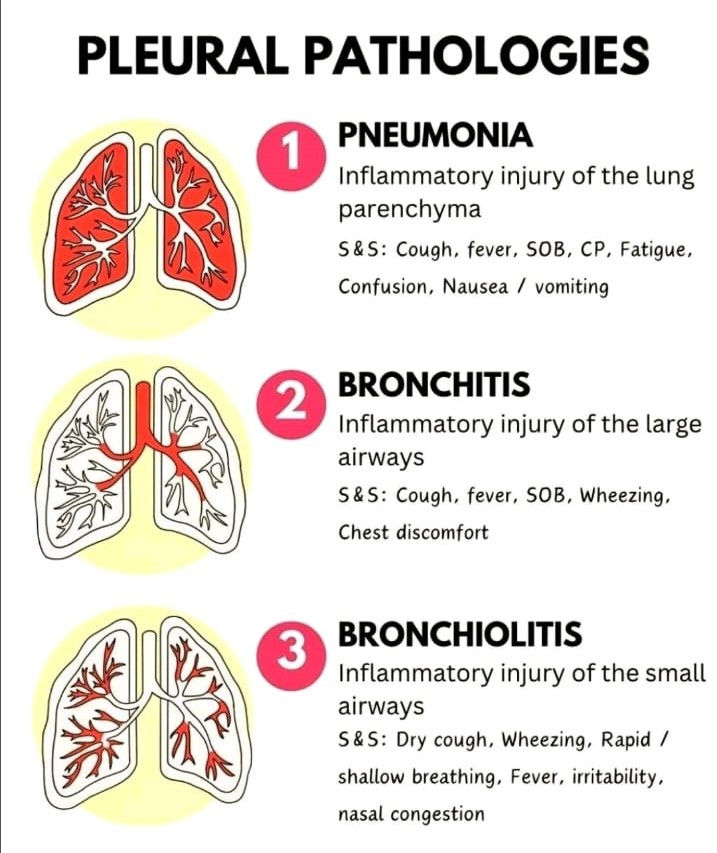Understanding Pleural Pathologies: Pneumonia, Bronchitis & Bronchiolitis
- Global Health

- Jul 20
- 2 min read
By Global Health Pneumology Insights

At Global Health, we believe that informed patients are empowered patients. Respiratory conditions are among the most common health concerns, and understanding the differences between them is key to proper treatment. Today, we’re shedding light on three important pleural pathologies—Pneumonia, Bronchitis, and Bronchiolitis—including their causes, symptoms, and treatments.
1. Pneumonia
What it is:Pneumonia is an inflammatory injury of the lung parenchyma, the part of the lungs responsible for gas exchange. It often results from bacterial, viral, or fungal infections.
Symptoms (S&S):
Cough (can be productive)
Fever
Shortness of breath (SOB)
Chest pain (CP)
Fatigue
Confusion (especially in the elderly)
Nausea and/or vomiting
Common Causes:
Bacteria: Streptococcus pneumoniae is the most common
Viruses: influenza, RSV, SARS-CoV-2
Fungi (in immunocompromised patients)
Treatment:
Bacterial pneumonia: Antibiotics
Viral pneumonia: Supportive care, antiviral medication in some cases
Supportive care: Rest, hydration, fever control
Severe cases may require hospitalization or oxygen therapy.
2. Bronchitis
What it is:Bronchitis is an inflammation of the large airways (bronchi) in the lungs. It can be acute (short-term) or chronic (long-term, often related to smoking or air pollution).
Symptoms (S&S):
Cough (often persistent)
Fever
Shortness of breath (SOB)
Wheezing
Chest discomfort
Common Causes:
Viruses (most common cause of acute bronchitis)
Bacteria (less common)
Irritants like smoke or pollutants (common in chronic bronchitis)
Treatment:
Acute bronchitis: Symptomatic relief (cough medicine, rest, fluids)
Chronic bronchitis: Inhalers (bronchodilators), corticosteroids, lifestyle changes (quitting smoking), pulmonary rehabilitation
3. Bronchiolitis
What it is:Bronchiolitis involves inflammation of the small airways (bronchioles), primarily affecting infants and young children. It’s most commonly caused by a virus.
Symptoms (S&S):
Dry cough
Wheezing
Rapid or shallow breathing
Fever
Irritability
Nasal congestion
Common Causes:
Respiratory Syncytial Virus (RSV) is the most common
Other viruses include adenovirus, influenza, and parainfluenza
Treatment:
Most cases are mild and resolve on their own
Supportive care: nasal suctioning, hydration, fever control
Severe cases may need oxygen therapy or hospitalization
Antibiotics are not effective unless there’s a secondary bacterial infection
When to See a Doctor?
Seek medical attention if you or a loved one experiences:
Difficulty breathing
High fever that doesn’t improve
Persistent wheezing or chest pain
Decreased appetite or dehydration
Confusion or drowsiness
Prevention Tips from Global Health
Vaccinate: Annual flu shots and pneumonia vaccines help reduce risk
Wash hands: Prevents the spread of viruses
Avoid smoking: Smoking damages airways and increases susceptibility
Healthy lifestyle: A strong immune system helps fight infections





Comments